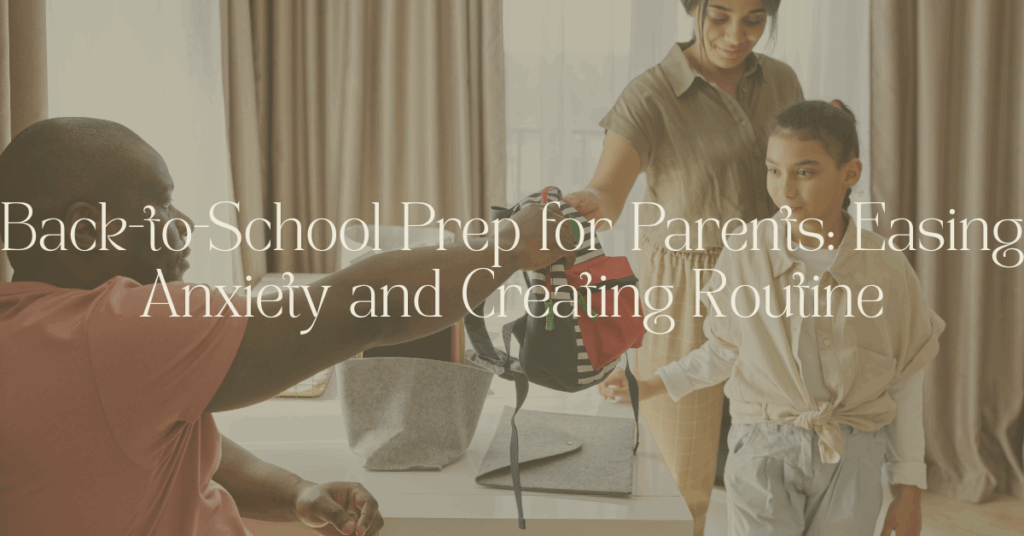The transition from summer freedom to structured school days can bring mixed emotions for both children and their caregivers. Excitement is often accompanied by nerves, and for some families, the return to early mornings, homework, and packed schedules can feel overwhelming.
At Refinery Counseling Services, we understand how stressful this time of year can be. Supporting your child’s mental wellness starts with creating emotional safety, consistency, and calm at home. This article offers practical, faith-integrated strategies for reducing back-to-school anxiety and building routines that support the entire family.
Why Back-to-School Transitions Are Emotionally Significant
Even when a child is returning to a familiar school, the shift in pace and environment can trigger:
- Anxiety about academic performance
- Worries about friendships or peer pressure
- Sleep disturbances due to changing schedules
- Emotional outbursts or withdrawal
These behaviors are common signs that your child is adjusting. For parents, increased demands may stir feelings of inadequacy, guilt, or stress. Recognizing the emotional weight of the transition can help families prepare with more grace and less pressure.
Step 1: Acknowledge and Normalize Feelings
Start conversations early. Create space for open dialogue by asking questions like:
- “What are you looking forward to?”
- “Is there anything you’re feeling nervous about?”
- “What would help you feel ready?”
Normalizing their feelings reduces shame and opens the door for support. Reassure your child that it’s okay to feel uncertain or overwhelmed—and that they won’t have to navigate the change alone.
Step 2: Re-establish Routines Gradually
Children thrive on structure. A gradual return to routines helps regulate their bodies and emotions:
- Shift sleep and wake times 1-2 weeks in advance
- Reintroduce morning rituals like breakfast and quiet time
- Set screen time limits and re-establish reading or study habits
This sense of rhythm not only soothes anxiety but also reinforces stability and predictability.
Step 3: Prepare Emotionally, Not Just Logistically
Back-to-school prep often focuses on supplies, lunches, and clothes. But emotional readiness is just as important:
- Read books about returning to school
- Visit the school or meet the teacher (if possible)
- Role-play common scenarios (e.g., asking for help, making new friends)
You can also use affirmations or faith-based encouragements:
- “God goes before you and is with you” (Deuteronomy 31:8)
- “You are brave, loved, and never alone.”
Step 4: Create a Calm-Down Corner or Transition Space
Transitions are hard. Consider setting up a calming space at home for when emotions run high:
- Include a journal, soft blanket, calming Scripture cards, or music
- Allow children to use the space after school to unwind and regulate
- Model healthy coping by taking timeouts for yourself, too
Step 5: Prioritize Connection Over Perfection
Don’t let the pursuit of a flawless routine override the need for connection. Prioritize heart-checks over checklists:
- Spend 10 undistracted minutes with your child daily
- Use car rides and bedtime as quiet moments for conversation
- Focus on what your child needs emotionally, not just behaviorally
Support is more impactful than structure alone. For more ideas on emotional support, visit Helping Kids Cope with School Stress and Transitions.
Step 6: Set Boundaries and Adjust Expectations
You can’t do it all—and you’re not meant to. Back-to-school season is a time to:
- Say no to overscheduling
- Build margin into your calendar
- Lower the pressure for perfection at home
Boundaries protect both your peace and your family’s emotional well-being. For guidance, see Setting Boundaries Without Guilt.
Step 7: Lean into Community and Support
Connect with:
- Other parents for shared wisdom
- Teachers for insight into your child’s needs
- Therapists for guidance if anxiety persists
Remember, therapy isn’t only for crisis. Therapy Is Not Just for Crises: 5 Myths About Mental Health Support explains how counseling can be part of proactive emotional care.
Final Thoughts: Grace for the Journey
Back-to-school season is a time of renewal—new rhythms, new growth, new chances to walk alongside your children with empathy and intention.
You don’t have to be perfect. You don’t have to have it all together. What matters most is presence. Let your children feel seen, heard, and supported. Let grace lead your home into the school year.

